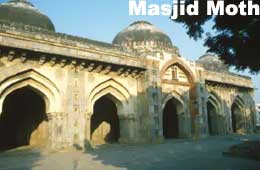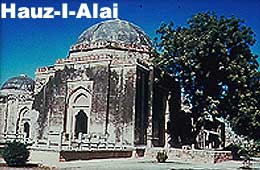| India Profile » Monuments and Temples in India » Lesser Known Monuments of Delhi | |
Lesser Known Monuments of Delhi | |
 | |
|
>
Masjid Moth
On one particular day Miya Bhoiya was strolling along with the king when the King suddenly bent down and picked up a grain of lentil or the moth ki dal. The king then presented the grain to his minister, Wazir Miya Bhoiya. Amazed at the gift given to him, the minister accepted it with matching humility and gratitude. On going home, the minister spent the whole night speculating over what should or could be done with the gift that had been bestowed on him by the king. Initially he thought that the grain should be thrown away. He, later, realized that if it were thrown away, then it would amount to disrespect to his king. So he thought of the ways to ensure that it should be protected in the proper manner. As dawn broke, the minister felt that it would be a good idea to plant the grain in his garden, which was quite huge. After that, he sowed the seed in the ground and dug the ground often to check if the seed was intact. He did not have to do it for long as the seedling grew with remarkable speed. In the first year itself, it gave as many as 200 grains of yield. Within a few years, the minister had multiplied the produce so much that history records a seed revolution. There was so much surplus that the minister decided to build a masjid from the income that came from the produce of moth. After the mosque was complete, he went to Sultan Sikander and invited him to visit the monument built from his gift. So pleased was the King with the minister that he even named the building, Moth ki Masjid or the Mosque from the Moth Lentil. Agar Sain Ki Baoli The Agar Sain ki Baoli is a short walk from Jantar Mantar towards Kasturba Gandhi Marg. It is a small structure built of rubble and dressed stone. It was once known as a citadel of peace. The baoli is shaded by a massive neem tree from the side where it has no roof. The northern end of the baoli is a raised platform, which is roofed. Baoli is a stepped well to store natural water, constructed in a manner whereby one could get water and also resting space for a traveler. The Agar Sain ki baoli has five levels where each level has an arched area, which was used as a resting place. The center of the well has water and the water is also linked to a well dug in a covered platform. The story behind the beautifully constructed well is a mystery since there are no historical records to give an insight into who built it. Legends say that it was constructed by a king called Agar Sain who ruled over Agra many centuries before Sikander Lodi of the Lodi dynasty. The king was a frequent traveler to Delhi and thought it fit to construct a place where one could rest in cool environs. Some legends tell us that the name could have been derived from Ugar Sain, who was supposed to be the father of Kamsa, the uncle of Krishna. The Agar Sain ki baoli is a wonderful example of the stepped wells constructed during the past but continues to remain neglected and uncared for. Such structures definitely are among the many things that tourists especially those coming from across the seas would like to admire if for nothing but the novelty of the concept.
The city of Delhi is bestowed with many ancient water reservoirs called baolis. The kings of various dynasties that ruled this historic city built them. A baoli or step-well consists of two parts: a vertical shaft from which water is drawn and the surrounding inclined subterranean passageways, chambers and steps, which provide access to the well. The galleries and chambers surrounding these wells were often carved profusely with elaborate detail. They played the role of resting place for the travelers during summers. The Hauz-I-Alai or the Hauz Khas Pond is a large reservoir constructed by Alauddin Khilji (1296-1316 AD). It went into disuse soon after his death in 1316 AD. Feroz Shah Tughlaq rebuilt it during his reign almost 50 years later. The Hauz-I-Alai was magnificent structure enclosed by masonry walls. It had dried up and lay almost buried under wild growth and some cultivation till Firoz Shah Tughlaq chanced upon it one day. He prided it as one his major achievements to have been able to excavate the pond, cleaned and filled it with water once again. The place came to be known as the Hauz Khas when Firoz Shah built a college at one end and the building started looking magnificent. The enclosure, which is irregular, was like the pond also enclosed by stone and cement. Firoz Shah's tomb is also in the complex. Today while there is little water, the lake's area is evident. Delhi Tourism holds some entertainment programmes there and Alauddin's tank now serves as an excellent backdrop to cultural events. |
|
 |
 The Masjid Moth was built by Wazir Miya Bhoiya, the minister of king Sikander Lodhi, during the 16th century AD. It is located between the present day Uday Park and the South Extension Part II area of South Delhi. There is an interesting story regarding the construction of the mosque. The land on which mosque was built was a forest land.
The Masjid Moth was built by Wazir Miya Bhoiya, the minister of king Sikander Lodhi, during the 16th century AD. It is located between the present day Uday Park and the South Extension Part II area of South Delhi. There is an interesting story regarding the construction of the mosque. The land on which mosque was built was a forest land.  Hauz Khas Pond
Hauz Khas Pond